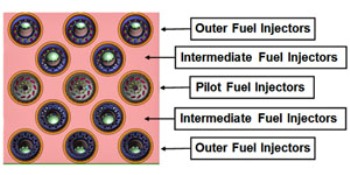May 28 2013
A team of researchers led by Ephraim Gutmark, the Ohio Regents Eminent Scholar Chaired Professor of Aerospace Engineering and Engineering Mechanics at UC, and including UC doctoral students Brian Dolan, David Munday and Rodrigo Villalva, is working with United Technology Aerospace Systems (UTAS) to develop a more efficient jet engine that produces fewer emissions. The effort is an outgrowth of NASA’s Environmentally Responsible Aviation Project, which explores vehicle concepts and technologies designed to reduce the impact of aviation on the environment.
 A UC research team led by Ephraim Gutmark analyzed an innovative array of fuel/air injectors for next-generation aircraft engines.
A UC research team led by Ephraim Gutmark analyzed an innovative array of fuel/air injectors for next-generation aircraft engines.
The research by Gutmark and his team, “Medium Pressure Emissions of a Multi-Point Low NOx Combustion System,” will be presented at the American Society of Mechanical Engineers International Gas Turbine Institute’s Turbo Expo, held June 3-7 in San Antonio. The 58th annual event unites leading experts in the turbomachinery industry to share the latest innovations.
The researchers worked with UTAS’s Multipoint Lean Direct Injection (MLDI) system – a unique take on aircraft engine combustion chambers. Whereas a typical aircraft engine might have a single row of large fuel injectors in its combustor, the MLDI system uses several rows of smaller injectors. The result, researchers have found, is more widely distributed combustion that is less prone to instabilities and generates less nitrogen oxide emissions.
“Usually in the existing gas turbine engines, the combustors have relatively big fuel elements where the fuel is injected and mixed,” Gutmark says. “The idea here was to replace them with smaller ones, but there are more of them that can actually distribute the combustion instead of having it focused in one concentrated zone.”
An added advantage of having more injectors is the larger degree of control a pilot has. With many more points of combustion, changing fuel consumption can be done with greater precision to accommodate the engine’s differing thrust needs for taking off, landing, taxiing or cruising.
“You can change the mixture of what you’re running much easier than when you have one concentrated location. The flexibility of operating the engine becomes much easier,” Gutmark says.
More fuel control also leads to even fewer emissions. It’s an important objective for companies such as UTAS, which hopes this project can produce service-ready technology that will reduce landing and takeoff cycle nitrogen oxide emissions by 75 percent of the International Civil Aviation Organization standards by 2020.
BUILDING INDUSTRY RELATIONSHIPS FOUNDED ON TEAMWORK
UC’s relationship with UTAS goes back for more than 10 years, when the company was known as Goodrich Aerospace. UC was helping Goodrich refine its fuel injectors even then, and a few years later the partnership grew when UC completed its Combustion Research Laboratory at the Center Hill Campus with funding through Ohio’s Third Frontier economic development initiative.
Gutmark says UC’s unique combination of high-tech facilities and advanced research acumen makes the university an attractive and successful partner for industry. Over the years he’s worked on a broad range of projects with companies from across the country – Boeing in Washington, Halliburton in Texas and General Electric in New York or here in Cincinnati.
“We have in our lab a very unique capability of providing support to industry in understanding basic phenomenon and developing new technology and applying very advanced diagnostics, experimentation and the computations to solve their problems and produce innovations that will lead them to new products,” Gutmark says.
Gutmark also points to a three-pronged strategy that has helped enable him to enjoy such mutually beneficial collaborations with industry: treat industry as part of your team; adhere to the industry time line for each project; and show industry partners how your input contributes to their bottom line.
“Dealing with industry as a team, rather than two separate entities, that’s a very important part of our success. We show them we can give them new ideas for new products. That contributes to their commercial success, and that brings more investment in the university,” Gutmark says.
Additional contributors to the research paper were UTAS’s Jerry Goeke, Spencer Pack, Jason Ryon and Gregory Zink. Funding for this study was partially provided by the NASA Glenn Research Center.
UC2019 ACADEMIC MASTER PLAN
Gutmark’s work supports the goals outlined in the UC2019 Academic Master Plan by producing new ways of understanding and transforming the world through research and scholarship; creating a deliberate and responsible approach to our environment; and enhancing and expanding collaborative engagement with our urban environment and throughout our global community.